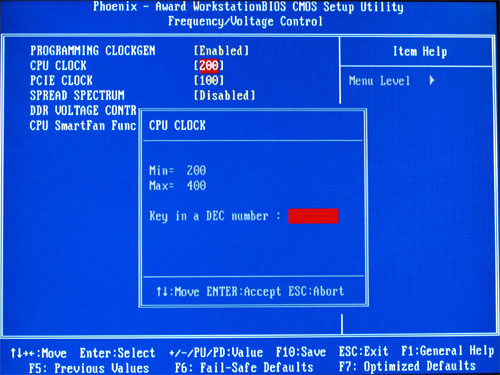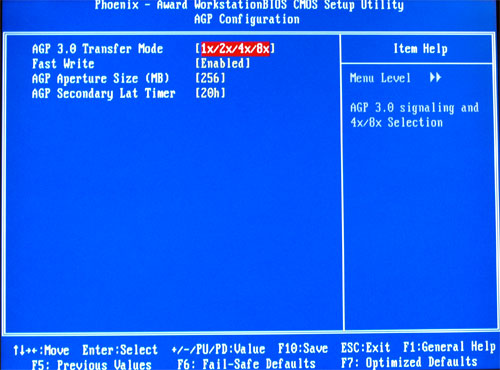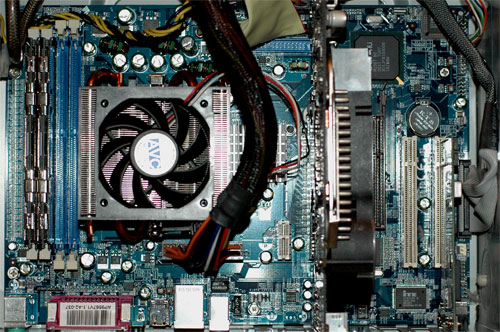FIRST LOOK: ULi M1695 PCIe/AGP Socket 939 for Athlon 64
by Wesley Fink on July 13, 2005 12:05 AM EST- Posted in
- Motherboards
Basic Features: ULi AP9507A (M1695/M1567)
| ULi AP9507A (M1695/M1567) | |
| CPU Interface | Socket 939 Athlon 64 |
| Chipset | ULi M1695 Northbridge - ULi M1567 Southbridge |
| BUS Speeds | 200MHz to 400MHz in 1MHz Increments |
| PCIe Speeds | 75-125MHz in 1MHz Increments |
| PCI/AGP | Fixed at 33/66 |
| Core Voltage | Startup, 0.825V to 1.55V in 0.025V increments |
| CPU Clock Multiplier | Startup, 4x-25x in 1X increments |
| HyperTransport Frequency | 1000MHz (1GHz) |
| HyperTransport Multiplier | 200, 400, 600, 800, 1000 |
| DRAM Voltage | NO Adjustments |
| HyperTransport Voltage | NO Adjustments |
| Memory Slots | Four 184-pin DDR DIMM Slots Dual-Channel Configuration Regular Unbuffered Memory to 4GB Total |
| Expansion Slots | 1 PCIe x16 (or 2 PCIe x8) 1 AGP 8X 2 PCIe x1 2 PCI Slots |
| Onboard SATA/RAID | 2 SATA Drives by ULi M1567 (RAID 0, 1, JBOD) |
| Onboard IDE/IDE RAID | Two Standard ATA133/100/66 (4 drives) |
| Onboard USB 2.0/IEEE-1394 | 8 USB 2.0 ports supported by ULi M1567 No Firewire (Optional) |
| Onboard LAN | 10/100 Ethernet by Realtek PNY (Gigabit LAN Optional) |
| Onboard Audio | AC '97 2.3 6-Channel by Realtek ALC655 |
| BIOS Revision | Award OC50624A (6/24/2005) |
The ULi Award BIOS provides a wide range of BIOS control options, particularly considering that this is a Reference Board used to qualify a chipset. The wide 200 to 400 range for CPU clock was a pleasant surprise, but it is somewhat academic with no memory voltage controls present in the BIOS.

The included vCore adjustments and PCIe speed adjustments were also a nice addition, although the range to just 1.55V is very limited for Clawhammer processors, which are 1.50V at default.

Since the ULi implementation of AGP is real AGP and not derived, the AGP adjustments will look familiar to AGP owners.
Reference Boards are designed for qualification and not for production. It would therefore be a mistake to dwell on the Reference Board layout, except to say that Reference Boards often influence layout of production boards. IDE, SATA, video slots and bottom edge headers all work fine where they are located. However, we hope that production boards will take a different approach to the location of the 24-pin ATX power connector. Located in about the center of the board between the CPU and rear IO ports, there is really no good way to route the heavy cable. In the center of the board, you have to be careful not to interfere with air flow or operation of the CPU and memory.
The location of the floppy connector at the bottom of the board will be a long reach for floppy users. Many buyers don't care about floppies any more, but if you still use them, the bottom of the board is an inconvenient and hard-to-reach location.











72 Comments
View All Comments
jpkomm - Tuesday, August 2, 2005 - link
In reference to the comments on ASrock's making of this board, I got word back from their US sales division as to when their board will actually be released in the US market. They said they have no plans on selling the "939Dual-SATAII" motherboard in the US region. Oi that bites. Anyone know of other companies planning on producing these boards? The ASrock board looks and (from the reviews) performs great, but I'm not going to hold out for the chance that it never comes to the US market.justly - Wednesday, August 3, 2005 - link
Are you actually surprised by this? I would probably do the same thing since most Americans will only purchase a product surrounded by marketing hype.
ElJefe - Monday, August 22, 2005 - link
the dual sata 939 will be sold in the US. asrock said it, asrock america sales said it too................(just in case anyone reads this thread... but the real discussion is in the 2nd, newest article here at anandtech)
hazeldene - Tuesday, July 19, 2005 - link
I wonder if you would be able to use an ATI AGP X-Series card as a Slave with an ATI X-series crossfire in the PCI-express slot... that would be the cheapest Crossfire / SLi upgrade ever !!!mistersnail - Monday, July 18, 2005 - link
http://www.hkepc.com/hwdb/m1695-uli-1.htmCrossfire can be done on this board
val - Sunday, July 17, 2005 - link
#65 last but not least. Suyin is usually the very last thing company does. So buy it until you can. We loves all of you who look to only syntetic tests and benchmarks, we have cheap intel cpus - thanks to you .val - Sunday, July 17, 2005 - link
#65 if you have in your room already 35, than there is something wrong with your room planing. No pcs can change it if you are still running heating or teaching in stove. And saying it last, do your math and learn what percents and thermall loss means. The difference to AMD platform is in percents of complete amount of heaters in room small and thermal loss increases exponentialy.However, world proves that some heating issues cannot change the fact that no "fanatic - glad of self punishment" admin would install room of amd systems.
mino - Saturday, July 16, 2005 - link
#62 it was not mentioned exactly anywhere (no one knows it actually) but rough estimate is 4 to 8 weeks. I believe it will be much closer to the seconf number.#63 One think I forgot something. Do you really believe it is technically feasible to guarantee 38C ambient temperature when the is about 35C in the room ?
mino - Saturday, July 16, 2005 - link
1) Actually I read tom's since they make some unique test sometimes. They are one of(many) relatively goog sites.2) Cooler classroom _will_ help mostly better learning/teaching, I said that.
3) Actually I like AMD's approach. However where bussiness is concerned only facts matter. I bought many Intel systems recently, but they were chosen because of their better suitability then. This is not the case here (meaning almost whole [prescott lineup).
4) actually in the room is normally running _single_ central heater. You forgot that rooms are not allways build in separate building. In this case only contacts with the outside are windows. Also remember the radiation form of heating causes lower temperature than convection at the sam output. The out pu t during the day should be around ~200W/machine(incl.LCD) + 1kW of lights make ~7kW which is close to your number. This however considers idle state, but there are working people about 50-70% of time so real average would be about 8kW for prescott room.
5) Anobody saying idle Prescott PC+LCD will consume about 100W of power is either mislleading or has no idea what he is tlaking about. This figure however fits our Newcastle's nicely.
6) Yes anybody could suck any number of any claims out of its finger anytime. Nothing new here.
What matters to me our academic society could work in these new classrooms without major health issues and having to abuse IT staff for what they bought.
That is what make me happy no matter what you think.
val - Saturday, July 16, 2005 - link
#60: it is whole crap.You are reading too much toms hardware. Intel is not throttling when you install cooler properly.
Cooler classroom will not help to admin when he have to spend there every day one hour.
You are talking like typical AMD fanboy, using untrusted claims which nobody would ever believe. Trust me, that 5100W running 8 hours a day will not heat up to 30° when outside is -10 with "any" isolation.
And even if it would, it would not heat it much more than 3000W using any power saving PC.
I can suck out of my finger 20 claims like that one you posted - if you want, so save your time writing stories.